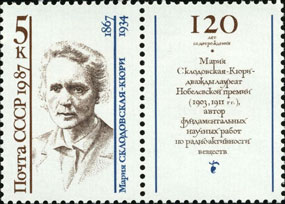Marie Curie Biography – Women in Medicine
Posted June 17, 2014 in Holiday Traditions by Dianne Weller

Our 3rd installment in “Women’s Accomplishment’s” series of blog articles, we feature Marie Curie! She came into the world on November 7th in the year of 1867 as “Marie Sklodowska” in Warsaw, which is located in Poland. Marie’s parents were both educators at the time of her birth. The youngest of the five children birthed by the educators, Marie always displayed a highly inquisitive nature and was exceptional in academics. According to those that knew the family, it seemed that Marie had many similarities to her father, an instructor that taught both mathematics and physics. Today, Marie Curie is known as the first female to win the Nobel Prize. She was also the first female to obtain the award in more than one subject; both chemistry and physics. She is also celebrated for her discovery of polonium, radium, and X-rays.

Photo Credit: Wikipedia
As a child, Marie Curie was permitted to receive a basic education in the schools within her vicinity. In addition to this, her father also educated her in scientific studies, at length. Marie was a passionate child and desired to learn all that she possibly could so that she could understand the world around her, and her unique role in that world. At the age of ten, Marie experienced an immense tragedy – the death of her mother, Bronsitwa, who lost her life from a tuberculosis infection. Just a few years earlier, the oldest child of the family, Zofia, had contracted typhus from an individual that boarded at the household. Throughout her life, Marie had observed her mother, a Catholic, and her father, an atheist, differ in beliefs. Once she was impacted by the deaths in the family, Marie turned from Catholicism and became an agnostic.
Marie Curie Biography – Educated in Paris, France
In the year of 1891, Marie Curie went to Paris to study alongside of her sister, Bronislawa. It was in Paris that she obtained several educational degrees and pursued her passion in science. While studying, she met a man named “Pierre Curie”, who shared her passion in science. Pierre was an instructor at the school she was attending and allotted Marie space within his laboratory to conduct scientific-based studies and experiments. The two were immediately drawn together and developed deep feelings for one another. Eventually, Pierre proposed to Marie. Unfortunately, she declined the proposal as she desired to return to Poland. Time progressed, both advanced in their education, and eventually, the two were married – on the 26th day of July in the year of 1895.

Marie always admired the work of two individuals – Henri Becquerel and Wilhelm Roentgen – who both specialized in studying uranium rays and X-rays. She elected to continue their studies and discovered a lot of valuable information pertaining to the atomic structure of the rays. She then developed the word, “Radioactivity” to express the phenomenon of the atomic structure. By 1897, she and her husband had one daughter, named Irene. The couple continued to study the radioactivity of the element after the birth of their daughter. They named it “Polonium”, after Poland. In their work, another element was discovered. This, they called, “Radium”. By the time 1903 rolled around, Marie had received the Nobel Prize in physics. The following year, a second child, Eve, was born.
The First Female Teacher at Sorbonne
In 1906, Marie and her children experienced the loss of Pierre. The grief was immense, but, she took her husband’s post as an instructor and became the first female teacher at Sorbonne. In 1911, she won her second Nobel Prize – this time in chemistry. When accepting the award, she acknowledged her late husband’s contributions and honored him. Immediately thereafter, it became public knowledge that she had a relationship with Paul Langevin. Despite the complications that arose from the public over her relationship, she continued to pursue her passion and her work. In the year of 1914, when World War I developed, she dedicated herself to offering assistance during the period. She is most notable for utilizing X-ray machines that were portable during the time. These small machines were referred to as, “Little Curies”.

Marie Curie in a Mobile X-Ray Unit. Photo Credit: Wikipedia
Death by Prolonged Exposure to Radiation
On July 4th in the year of 1934, Marie Curie died from a condition called, “Aplastic Anemia”. According to medical professionals, this condition was likely caused by the prolonged exposure that she had to the radiation that she studied at depth throughout her lifetime. Since her death, she has been hailed as the most famous woman scientist that the world has known. Her children continued her studies in radioactive elements and have continued to offer the world their knowledge. In addition to this and as a tribute to the Marie Curie biography, many educational facilities of today carry the name “Curie”, such as the “Institute Curie”, located in Paris, France. Marie Curie was more than just a female interested in science; she was a true pioneer and legacy in the scientific community.
